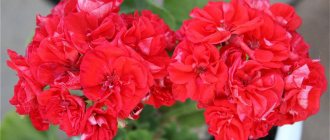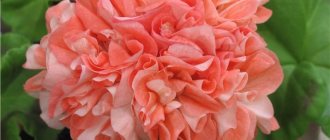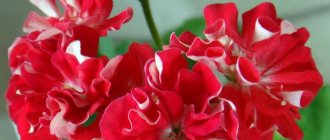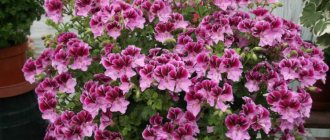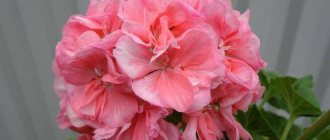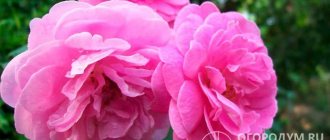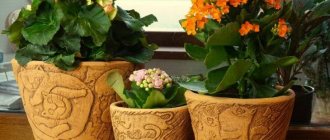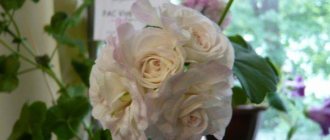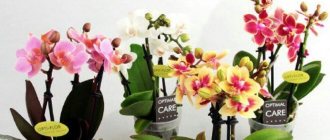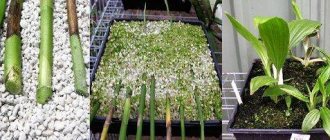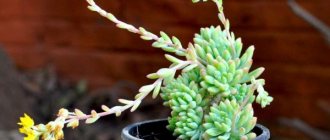Appearance and characteristics of pelargoniums
There are about 250 varieties of Pelargonium Toscana. The most favorite plants of gardeners are Bernd pelargonium, Regina species, Tammo and others.
The stem of the flower can be straight or curly, and the leaves can be carved and terry. But the defining characteristic feature is the inflorescences themselves - bright or soft pink flowers of 4 petals, which are collected together into a bouquet.
Royal pelargonium is valued for the unusual color of its semi-double petals.
This is interesting! Sometimes in descriptions the flower is called “Tuscan geranium”, but this is wrong, pelargonium just belongs to the geranium genus.
Planting and further care of ivy-leaved pelargonium Tuscany
Caring for ivy-leaved pelargonium Tuscany is simple. Planting technology may vary depending on the location of cultivation, since the crop grows well in the room, on the balcony and in the garden.
Planting a plant
The flower prefers relatively hard soil, which combines turf and leaf soil, peat and sand.
It is important to take care of the looseness and filling of the soil with oxygen.
Watering, spraying and fertilizing
Before and after planting, the plant is watered abundantly for two weeks. Then, in hot weather, it can be watered every other day, and in cold weather - 2 times a week. It is better to install drainage under the pot to absorb excess moisture. Spraying the flower is necessary only on very hot days.
Note! To bloom for many months, you should fertilize the flower with universal compounds at least once every two weeks.
Trimming
The procedure is required to achieve maximum flowering duration. There are three types of pruning:
- The main thing is that it is done in early spring; you can safely trim the long stems and give them shape, since new ones grow very quickly.
- Autumn - removal of dry leaves and diseased stems.
- Pinching throughout the year.
How to prune a flower
Diseases and pests, ways to combat them
Diseases of zonal pelargonium manifest themselves in yellowing, rotting and dryness of leaves. The most common reasons: lack of light, too much watering, poor ventilation and insufficiently clean substrate.
Important! Treatment is carried out by quickly removing the diseased part of the flower and eliminating the cause of the disease. Frequent plant pests are aphids and whiteflies.
When they are detected, insects are first collected by hand, then the flower is treated with an insecticide solution
Frequent pests of the plant are aphids and whiteflies. When they are detected, insects are first collected by hand, then the flower is treated with an insecticide solution.
Pelargonium Toskana, which is so often called geranium, is a real decoration of the home or garden. Lush bushes with dense umbrellas of flowers look luxurious and impressive.
Basic rules of care
The basis for caring for plants is watering and fertilizing. Native to South Africa, pelargonium tolerates some drought but does not tolerate spraying or showering its flowers and leaves well. Water the flower in the pot with warm, soft water so that only the top layer of soil is moistened. Excess moisture is drained from the pan, preventing the water from stagnating.
During the hot season, daily watering is recommended, and when the plant goes into a dormant period, the frequency of watering is reduced to twice a week.
You can feed the flower with special fertilizers for flowering plants that contain a minimum of nitrogen, since this element causes rapid growth of green mass to the detriment of flowering. Organic fertilizers for geraniums are not recommended, but you can water them with an iodine solution by adding just one drop of the substance per liter of water . The liquid is spilled along the edge of the pot so as not to burn the roots.
Geranium loves well-lit places where it needs to be protected only from the bright midday sun. Due to lack of light, zonal pelargonium loses its brightness, the leaves become monochromatic, and the stems become elongated. The best length of daylight for long and lush flowering is 12–14 hours.
In winter, you can use additional lighting to preserve the decorative appearance of the flower.
In autumn, when flowering ends, and in early spring, geraniums are pruned to form a bush. The peculiarity of the flower is that during the process of growth its lower leaves constantly die off, which is why the plant stretches out and the bush becomes loose and ugly. You can trim to the required height, even if bare stems remain. They have dormant buds, which after pruning will begin to develop, producing new shoots.
Pelargonium Edwards Pleasure
Plants with this shipping deadline are sent out from April 1 to May 30 in the order in which orders are received.
Plants with only one delivery date are placed in one order!
For all planting material
Dozens of payment methods
Fast and convenient delivery
Russian Post (Moscow and region within 24 hours), SDEK, Courier
Pelargonium Edwards Pleasure (Edwards Pleasure).
Dwarf zonal pelargonium. The bush is stocky and branches well. The inflorescences are double, large, warm salmon-colored with light tints.
Planting pelargonium: Even a novice gardener can plant pelargonium in the garden - the process does not require compliance with any complex rules. You just need to remember about the long roots of the plant when digging holes about 20 cm deep. When planting, it is better to leave a distance of 20-30 cm between the bushes.
Caring for pelargonium: Pelargonium requires systematic moderate watering: the soil should not be allowed to dry out or there should be a large amount of moisture in the soil. The flower does not need spraying. Garden varieties of pelargonium do well in partial shade; flowering is weak in direct sunlight. Therefore, on particularly hot days, darkening is required. The optimal air temperature for garden plants is no more than +20 °C.
Soil for planting: Pelargonium Edwards Pleasure (Edwards Pleasure) is quite demanding on the soil. The ideal solution is unused, loose soil with good drainage. For young plants without a formed root system, light soil is more suitable, so sand and peat, vermiculite and perlite are added to the composition. The soil for planting must be sufficiently fertile and well-drained. Pelargonium should not be planted in loamy and clayey soils.
Preparing for winter: Already in the fall, the pot with the plant is placed in a cool and dimly lit place. A southern or northern window sill in a house/apartment is quite suitable for this, since there is diffused sunlight there. And to make up for the lack of light at this time, you can use fluorescent lamps. The optimal daylight hours are 12 hours.
Planting location: The ideal location in the garden for Edwards Pleasure pelargonium will be in sunny areas. However, even in partial shade it is able to fully develop and bloom profusely throughout the season.
Reproduction of pelargonium by cuttings: You need to prepare a sharp knife or scalpel and disinfect it with alcohol. In no case should you use a blunt instrument, as this can damage the tissue of the cuttings and slow down the growth of future roots. Cuttings are cut from shoots directed at right angles to the main one, and at least 3 leaves should grow on them. For tall varieties of geranium, the length of the cuttings should be about 5-7 cm, for short and miniature varieties - 2.5-4 cm. The cut is made at right angles to the stem.
Quality guarantee For the entire range
Zonal pelargoniums - Zonal pelargoniums
The most common species, represented by the largest number of varieties (more than 75 thousand). This pelargonium received the prefix “zonal” because on its leaf blades there is a “zone” painted in a different color - usually in the form of a ring or a spot of color in the center. When there is a lack of lighting, for example in winter, the “zone” disappears, and appears again in the spring.
Pelargonium zonalis is a densely leafy, upright bush with flowers collected in umbrella racemes. Its leaves are pubescent and have a specific smell.
Cultivation of zonal pelargonium began in 1710. These inhabitants of window sills were tall and looked like a long tower with small inflorescences. Later, breeders began to develop shorter varieties that could be shaped by pinching. The first such varieties appeared in 1844.
According to the number of flower petals, zonal pelargoniums are divided into:
- non-double (Single Zonal pelargoniums) - the flower consists of 5 petals;
- semi-double (Semi-Double Pelargoium Zonale) - from 6-8 petals;
- terry (Double Zonal pelargoniums) – more than 8 petals.
Among the mass of varieties of zonal pelargoniums, separate subgroups are distinguished:
Rosaceae (Rose-bud Zonal pelargoniums)
Zonal pelargoniums with flowers very similar to roses. The first mention of the subgroup appeared in 1876, in an article in the Journal of the Royal Horticultural Society. The most famous variety is Appleblossum Rosebud.
Tulip-shaped (Tulipe-bud pelargonium)
Pelargonium flowers resemble unopened tulip buds with 6-9 petals. The subgroup is characterized by dense flowering in the form of a bouquet. Tulip-shaped pelargoniums were obtained in 1966 by the American family of breeders Andrea in Boston. It is believed that the ancestor of the subgroup was the sport (mutation) of Fiat pelargonium, to the appearance of which varietal “tulips” sometimes return.
The flowers of this subgroup resemble the flowers of carnation. They are quite large, with carved petals.
Stellar Zonal Pelargonium
These zonal pelargoniums have both leaves and flowers with a sharp, angular, so-called “star” shape. Typically, a flower has two upper petals that are more elongated and narrower than the rest. Star pelargoniums first appeared on the windowsills of amateur gardeners in the early 1950s. in Australia.
Cactus-flowered Zonal pelargoniums
A very rare subgroup of pelargoniums characterized by long, curled or curled flower petals. They often appear "disheveled" or similar to cactus dahlia flowers. The cactus group has been known since the end of the 19th century; now most of the varietal assortment has been lost.
"Deacons"
The first "Deacons" arose from crossing the zonal miniature Orion and the ivy-leaved pelargonium Blue Peter. Breeder - Stanley Stringer. He presented new varieties of geraniums at the Chelsea Flower Show in 1970. The features of this subgroup are a compact, miniature bush and abundant flowering. The flowers are red, orange or pink in different shades.
More information about the ampel Pelargonium ivy-leaved
This type of pelargonium also belongs to the Geraniaceae family, but it is distinguished by the flattened shape of the leaf blade. Its leaves have a five-lobed shape, like ivy. The surface of the sheet plate is smooth and glossy.
In nature, ivy-leaved pelargonium has very strong leaves that can break through rocky soil. When grown indoors, they become softer and smaller.
The shoots of the plant are long and curly. Since the stems hang down, it is best to grow pelargonium in pots or cache-pots. The inflorescences of this species are similar to umbrellas, because one bunch can contain from five to nine flowers. The flowering period of the plant is not too long. It starts in spring and ends in July. The color range of inflorescences is also rich. On sale you can see planting material with almost any shade of flowers. Flowers may be unevenly colored, for example, have spots, stripes, borders, inclusions that differ from the main color.
Pelargonium and geranium are often confused, but they are not the same plant, they simply belong to the same family. Pelargonium was brought to European countries at the beginning of the 17th century from Africa. The length of an adult plant can reach one and a half meters, so it is better to place the flower on a stand or grow it on a balcony. In nature, this species can be found in Italy, Spain or China. It prefers to grow in hot or temperate climates.
Among the plant species you can find varieties with double flowers, which are shaped like roses or tulips. Usually the inflorescences are collected in umbrellas, and the flowers themselves have bright, rich colors. They can combine two tones.
Many varieties of hanging plants are created through selection, for example, the result of crossing ivy-leaved and zonal pelargonium was the group of hybrid varieties Toskana. These include Malaika, Marlen, Teske, Nixe. No less known to gardeners is the Tornado hybrid group, which can bloom for up to six months.
Description of popular varieties of pelargonium from the Toscana series
Thanks to the work of breeders, the color palette is wide, from soft marshmallow (Regina variety) to rich scarlet with dark spots (Dark Red variety). Varieties differ in color, shape, size and type of inflorescences.
Toscana Bernd
Pelargonium Toscana Bernd is a double and zonal beauty. Rare deep red color of inflorescences collected in bright bunches. Pelargonium Tuscany Bernd blooms profusely, covering the entire top with red balls.
Toscana Edwards
Pelargonium with red-orange inflorescences is distinguished by a white lining on the back of the petals and at their base. Pelargonium Edwards Tuscany blooms earlier than its sisters and blooms for a long time.
Toscana Renske
The red-burgundy small inflorescences of this variety densely cover the surface of the compact bush. The plant can be used as a hanging or potted plant. Blooms early and blooms for a long time.
Toscana Castello
Varieties of this variety come in many shades of red and pink. The inflorescences are dense and resistant to fading. The bush is medium, erect, suitable for planting in flower beds.
Toscana Hero
A beautiful combination of dark red-pink spots on the petals, with a white tint. The hiro bush is dwarf, and the inflorescences themselves are very large. The velvet shade shimmers in the sun. Blooms profusely, almost continuously. Medium size with the same flower color - Tammo geranium.
Varieties
Pelargoniums of any group have several series, differing in height, color and leaf shape. The flowers of the Toscana series are zonal. These low plants are characterized by a compact bush, large umbrellas of inflorescences and a flowering duration of about a month. Pelargonium Toscana has several varieties, differing in the colors of the buds.
- Toscana is a low branched bush, decorated with very beautiful inflorescences up to 100 mm in diameter, which when half-bloomed resemble a rosebud. The simple leaves of the plant have one dark ring located close to the petiole of the leaf.
- Toscana Bernd is a semi-double variety with red flowers that have a slightly brownish tint. From the middle of the bud, sparse white stripes are scattered across the petals. When the flower begins to wilt, the edges of the petals lose color, resulting in the inflorescence taking on a frosted appearance.
- Toscana Edwards is a double variety with bright orange flowers. The underside of the petal is whitish in color. The plant has short, strong peduncles. Edwards blooms early and produces profusely.
- Variety "Eric", or "Castello Orange" , is famous for its perfectly orange semi-double flowers among dark green foliage with a light zone in the center.
- Toscana Hero is a dwarf plant with simple bright crimson flowers with a white eye in the center. Light green leaves have faint dark zones.
- The soft pink geranium "Karen" with simple flowers in lush inflorescences rising above the dark foliage captivates with its tenderness.
- Tammo is a compact dark green bush with a cap of large inflorescences of simple fuchsia flowers with a dark red velvety spot in the center of the petal.
- Dolce Vita Lavender Lara has large pink-lavender simple flowers with a lightened center. The green leaves of the plant do not have distinct zones.
- Angeleyes amarillo burgundy is a hybrid developed from the compact royal variety Angeline. Flowers of this species resemble the shape of a pansy. Small green leaves are covered with a cap of few-flowered inflorescences of simple flowers the size of a five-ruble coin. The two upper large petals with a jagged edge and the three smaller lower petals are burgundy in color with a soft lilac edge. At the center the petals are covered with a light mesh.
- Pelargonium Regina has large umbrellas of semi-double flowers of crimson color with an orange center, rising above green leaves with a pronounced dark zone.
- Lenja has large semi-double salmon-colored flowers with a lighter border, collected in large spherical umbrellas.
- "Katarina" is a compact plant with medium green foliage and a faint zone. A cap of large lilac flowers with a pink tint and a red center adorns the plant for about a month.
These varieties are most common among indoor floriculture enthusiasts and landscape designers who use these flowers in their compositions.
Propagation from seeds
Pelargonium has fairly large seeds. The best growing period is from November to April, although sowing can be done at any time of the year
It is important to know that when grown from seeds, geranium may lose varietal characteristics
- Of particular importance for pelargonium is soft, loose and moisture-absorbing soil. In order to obtain it, you need to mix turf soil, peat, sand in a ratio of 2:1:1.
- Then you need to disinfect the soil.
- Seeds should be planted in soaked soil. The main thing is not to overdo it with water, since geranium does not like excess moisture.
- Seeds are placed in the soil to a depth of 1 cm.
- The temperature should be about 22 degrees.
- Before the first shoots appear, pelargonium must be covered with film or placed behind glass.
- A prerequisite for growing is to ventilate the greenhouse and moisten the soil.
- After the actual leaves appear, the film is removed and the future plant is moved into pots.
IMPORTANT: If you strictly follow all the rules, pelargonium will bloom 5-6 months after planting.
How a flower propagates: by seeds
This method is the longest and most labor-intensive, so in practice it is rarely used. In addition, when grown from seeds, varietal qualities deteriorate. Planting seeds is done in the spring. Planting material is purchased in advance at the store. A drainage layer of expanded clay is formed in the growing pots. Soil is poured into the container on top and watered.
Before planting, the seeds are soaked for 24 hours in a solution of a growth stimulator. After this, they are laid on the ground and lightly sprinkled with earth. The soil is sprayed from above and covered with film, putting it in a lighted place with a temperature of about 24 degrees. After eight to ten days, the first seedlings appear. After the third leaf, the seedlings are transplanted into separate pots.
Cuttings
This method of reproduction is considered effective. In spring, it is necessary to prepare layering. They are cut from the bush. Each cutting must be at least seven centimeters long and have at least two nodes. Layers are not placed in water, as the plant may rot. They are immediately rooted into the ground. The cut should be lubricated with a stimulator for the growth of the root system.
You need to make drainage in the planting container, fill it with soil and water it. Layers are buried in the ground so that the first node is above the substrate level. The cuttings are covered with a cut plastic bottle, and the container is placed in a bright, warm place. After three weeks, the cuttings begin to form roots. The first leaves appear on the shoots and are pinched off. Usually, if the procedure is carried out in spring, the plant begins to bloom in the first season.
Description of popular varieties of pelargonium from the Toscana series
Pelargonium PAC Viva Madeleine, Carolina and other varieties
Pelargonium Tuscany is especially popular. This is due to the fact that it can bloom all year round and is unpretentious in home and garden conditions. The lush bush not only decorates with delicate terry umbrella inflorescences, but also exudes a pleasant spicy aroma. The most popular varieties:
- Pelargonium Toscana Bernd. It is distinguished by large semi-double flowers up to 3.5 cm each and a rich cherry color. It is similar to the Tammo variety. Pelargonium Tuscany Bernd can be planted indoors, on the balcony or in the garden.
- Pelargonium Edwards Tuscany. It also has tight inflorescences and a lush shape. Pelargonium flowers of the Edwards Toscana variety resemble rosebuds.
- Variety Tuscany Renske. It has compact bushes with double burgundy flowers. The flowering period is from early spring to late autumn.
- Toscana Castello. Named after the beautiful castle, it amazes with its grandeur. Widely branched, colors range from white and soft pink to purple.
- Toscana Hero. Gardeners call this variety standard. The small size of the Hiro stem is combined with rich flowering.
Delicate bouquet of Edwards pelargonium inflorescences
Competition "The most abundantly flowering pelargonium"
Moderator: Floriana
Competition "The most abundantly flowering pelargonium"
Post by Nimfea » Mar 27, 2016, 9:43 pm
Let's resume this competition.
Competition "The most abundantly flowering pelargonium"
Participants in the competition must show a full-length photo of a blooming pelargonium so that you can see the size of the plant and the number of flowers on it. So, take pictures of your favorites in spring and summer! The plant can be indoor, balcony, garden, the main thing is that it is taken in a neat condition and there should be no clutter in the background. The photo and plant must be yours. If you know the name of the variety, then sign for a better search on the web for our competition.
from March 28 to September 15, 2016
Competition "The most abundantly flowering pelargonium"
Post by Galina55 » March 29, 2016, 10:20
I have the most profusely blooming Brookside Rosa.
Competition "The most abundantly flowering pelargonium"
Post by Callirya » Apr 01, 2016, 00:02
Competition "The most abundantly flowering pelargonium"
Post by Bagiro4ka » April 16, 2016, 8:30 pm
Barnstone Dale ampelous ivy leaf. From spring to October everything is in flowers.
Competition "The most abundantly flowering pelargonium"
Posted by mirioran » April 16, 2016, 9:19 pm
Competition "The most abundantly flowering pelargonium"
Post by NadiyaB » April 17, 2016, 00:42
Competition "The most abundantly flowering pelargonium"
Post by MAK » April 17, 2016, 02:05
Competition "The most abundantly flowering pelargonium"
Post by Olga55 » April 17, 2016, 09:28
Little Bloom Jim Haughton
Competition "The most abundantly flowering pelargonium"
Post by Bagiro4ka » April 17, 2016, 8:13 pm
My favorite PAC Mexico Ruby
Competition "The most abundantly flowering pelargonium"
Post by Pepino » April 18, 2016, 02:07 pm
Competition "The most abundantly flowering pelargonium"
Post by Nimfea » April 18, 2016, 05:41 pm
Competition "The most abundantly flowering pelargonium"
Post by LiliyaYa » 01 Jun 2016, 17:30
For summer decoration of windows at the dacha, I grow various pelargoniums. One of my favorites, ivy leaf
Competition "The most abundantly flowering pelargonium"
Post by Larchen » 01 Jun 2016, 18:47
Competition "The most abundantly flowering pelargonium"
Post by Natalia Korkotko » June 01, 2016, 11:08 pm
In principle, my Debby (sport) did not bloom as profusely as it could have. I have to beat my hands off for autumn pruning, and I understand this perfectly well. But nothing can be changed. Take this one.
Competition "The most abundantly flowering pelargonium"
Post by Svetlana_4ka » 05 Jun 2016, 14:28
after strong early spring pruning, my pelargonium Bold Carmine began to bloom
Competition "The most abundantly flowering pelargonium"
Posted by IA I » June 05, 2016, 21:16
Competition "The most abundantly flowering pelargonium"
Post by Svetlana_4ka » Jun 06, 2016, 11:01
Competition "The most abundantly flowering pelargonium"
Post by ELENA_K » Jun 07, 2016, 01:07
Competition "The most abundantly flowering pelargonium"
Post by KATErinka » June 21, 2016, 3:13 pm
Ivy Pelargonium Pac Tomcat
Although when they all bloom, it is difficult to choose the most flowery one.
Competition "The most abundantly flowering pelargonium"
Post by Luchik » June 24, 2016, 10:30
I also want to take part in the competition
PAC Aristo Darling.
Unstoppable, as I call it, started blooming last summer from a tiny cutting and still can’t stop. I never formed a beautiful bush for it, which is why it became very elongated due to the huge number of flower stalks. All winter she grew in a 7 cm pot, in the cold, albeit with lighting, I thought that at least this would stop her. But in vain, it blooms and blooms.
August 8 last, 2015. Start.
January of this year, 2016. We are still blooming without stopping.
February 5, 2016.
In the spring I transplanted it into a 13 cm pot and gave it free rein. Photo from June 22, 2016.
While she was twisting it to show the beauty from all sides, she slightly shed the petals.
Where and how to plant?
Choosing a location and lighting
So that there is a lot of light. If the gardener plans to plant a flower in open ground, then he must choose the most illuminated place. If we talk about an enclosed space, then in this case it is worth choosing a window sill on the south side. In the summer, you can take Pelargonium to a loggia or balcony.
Soil requirements
It is best to purchase ready-made soil in a specialized store. You can buy a universal substrate intended for planting indoor plants.
However, you can prepare the mixture yourself. To do this, use equal proportions of turf and leaf soil, coarse sand, humus and peat. When planting, it is advisable to immediately add fertilizers with a high level of phosphorus to the soil.
Pelargoniums will react negatively to organic fertilizers.
Recommendations for planting
- If you plant a plant with seeds, it would be good to treat them with a weak solution of potassium permanganate to protect the seed from various diseases and pests. The seeds should be lowered into the substrate approximately 2-3 centimeters deep; after sowing, the soil is sprayed with a spray bottle.
- In order for the seeds to germinate as quickly as possible, they need to be covered with film. But do not forget to ventilate the formed greenhouse so that condensation does not collect on it.
- As soon as the first shoots appear, the film must be removed.
- After the first pair of leaf blades appears, the young plants are planted in separate containers.
- Flowerpot. To plant Pelargonium Edwards, you need to choose a not very large pot. If the gardener plants the plant in a pot that is too large, flowering will not begin immediately. The fact is that until the root part fills the entire container, the ground part will not begin to develop fully.
Watering mode. Pelargonium is one of those flowers that can easily withstand periods of drought. Therefore, you should not moisten the soil too often and abundantly. The watering schedule depends on the air temperature around and the length of daylight hours. It is not recommended to water pelargonium if the soil around the rhizomes is not yet completely dry.
This flower does not tolerate waterlogging of the substrate. The described plant also does not like the excessively humidified air around it. Therefore, you should not spray both the flower itself and the air.
Trimming. This procedure is necessary in order to form a beautiful, even bush. To do this, it is worth pinching young shoots in time. As soon as the shoots begin to move upward very actively, they need to be broken off. This way, new leaf plates will appear at the pinching site, which will make the bush more lush.
Transfer. You should not carry out this procedure too often, as adult Pelargonium will respond very negatively to such manipulation. The plant’s “place of residence” should be changed only if the root system has become crowded in the previous container.
Diseases and pests
Even such an unpretentious plant is affected by pests and fungal diseases. In order to protect the plant from disease, you need to follow the watering regime, preventing powdery mildew, rust or gray rot from developing.
If signs of disease appear, the plant must be treated with fungicides. If a flower is affected by blackleg, the flower will have to be completely destroyed and the container disinfected.
Pelargonium has medicinal properties and repels most pests, but some sucking insects (like whiteflies or spider mites) can attack the plant. Insecticides are used to combat them.
To come in
Peculiarities
Pelargonium is a decorative flower from the Geraniaceae genus. To date, descriptions of about 250 species of this plant are known. Pelargonium is popularly called geranium, although this is scientifically incorrect. Plants belong to the same genus, but differ in appearance and have their own growing characteristics. Pelargonium, unlike geranium, is a heat-loving plant and does not overwinter in open ground. These two types of geraniums are united by the shape of the flower and the seed capsule, similar to the beak of a crane, for which the flowers got their name (geranium in Greek means “crane”).
A perennial herbaceous plant with an erect or creeping branched stem, it is grown in mid-latitudes as an indoor plant, which in the warm season is taken out to the balcony or placed in the garden. Carved leaves can be simple or dissected, with a velvety surface. Depending on the type of plant, the color of the leaves is solid green or with pronounced alternating light and dark zones. Types of geraniums with leaves of varying colors belong to the group of zonal pelargoniums.
Umbrella inflorescences of pelargonium, collected from simple or double flowers, are distinguished by their bright colors. Depending on the plant variety, the buds are single-colored or have several colors.
Due to the content of essential oils, geranium is used for medicinal and cosmetic purposes.
How to grow an ampelous flower, ivy-leaved pelargonium
Pelargonium ivy-leaved is familiar to many. Upright bushes can be seen on the windowsills of houses or growing in the garden, but hanging climbing varieties are only gaining popularity among gardeners. One of the most famous varieties of ampels of this plant is called ivy-leaved pelargonium. You can decorate your balcony with it or plant it on the window. Often this particular variety is used to create vertical gardening. The universal variety can be grown in the garden on a regular flat area. Here it will look like a dense green carpet with bright, catchy colors.
Growing Norrland pelargonium at home, care rules
If you follow all the rules of care, the flower will not cause problems or troubles.
Illumination and temperature conditions
Geranium Norland loves a lot of light, and stops blooming brightly and abundantly if there is not enough light. It is worth foreseeing in advance the possibility of burns appearing on the leaf blades of the bush, and placing the flower in a place with diffused light or on an eastern window.
The room should be warm, but not stuffy. In summer, it is useful to ventilate the bush at least twice a week. In summer, the optimal temperature for keeping pelargonium is +18... +25 degrees, with the arrival of winter it is gradually lowered to +12... +14 degrees.
Important! When ventilating the plant, you should not create strong drafts; they have a very negative effect on flowering.
Watering rules and humidity
The soil must be constantly moist, so it is necessary to water regularly. Their frequency will depend on the season: in the hot summer, the flower is watered at least 3 times a week, but with the arrival of winter, the frequency of watering should be reduced to 1-2 times. To prevent excess water from accumulating in the ground, it is loosened after each watering.
The water must be of high quality and clean; tap liquid must not be used. First, it is left to stand for almost 5-6 hours in a wide and shallow container. Stir it from time to time to remove all the chlorine. The water temperature should be identical to room temperature.
Humidity must be maintained at 70%. To increase it, it is recommended to spray the bush with a spray bottle.
The soil for growing should be nutritious and loose
Fertilizing and soil quality
To feed Norland pelargonium, only mineral fertilizers are used. Organics have too strong an effect on the roots of all types of geraniums. Fertilizing is carried out in liquid form twice a month.
Important! Fertilizers are applied only during the growing season and flowering. A flower needs a nutrient substrate
It is prepared by mixing light turf soil, peat, humus and coarse sand. The last component is necessary for good breathability and avoiding moisture stagnation. To increase soil drainage, a separate layer of drainage is covered at the bottom of the pot: expanded clay or brick chips, small pebbles, gravel
A flower needs a nutrient substrate. It is prepared by mixing light turf soil, peat, humus and coarse sand. The last component is necessary for good breathability and avoiding moisture stagnation. To increase soil drainage, a separate layer of drainage is covered at the bottom of the pot: expanded clay or brick chips, small pebbles, gravel.
Flower container size
The growing pot should be selected depending on the width and length of the root system. There is no need to choose a container that is too spacious, as this may cause flowering to stop.
Pruning and replanting
The bush needs to be regularly pruned to remove old and dried shoots, as well as thinned out. To do this, remove young lateral or internal adult stems. This procedure improves the quality of flowering.
The upper part of the bush quickly gains growth, but the root develops more slowly, so it is enough to replant once every 2-3 years. Geranium does not really like frequent transplants.
Note! When planting a shrub in a new pot, it is necessary to completely replace the old soil and fill all the voids between the rhizomes with a new nutrient substrate
How to plant a plant in the garden
It is best to plant the plant in open ground when the soil is well warmed up. At this time, the air is usually well warmed up, and the frosts have stopped.
If a pot is selected for growing a plant, then you need to know the capacity of the pot. You should not take containers with too large a volume. It should maximally exceed the volume of pelargonium roots by one and a half centimeters around the perimeter. The bottom of the pot should be lined with brick or pebble drainage.
After this, you need to prepare an earthen mixture, which consists of turf, sand, peat and humus. Half of the substrate needs to be poured into the pot, the bush should be lowered, and then the soil should be poured into the voids. The earth should not be compacted too much. After this, the bush is watered so that water does not get on its leaves. You can simply spray the soil with a spray bottle. If ivy-leaved pelargonium is planted in a garden bed, then you need to make several holes with an interval of at least 20 centimeters. The planting material goes deep into them no more than two centimeters. This way, root shoots will form faster.
